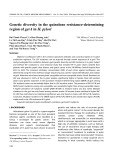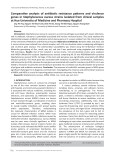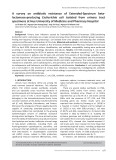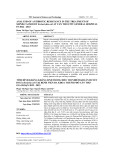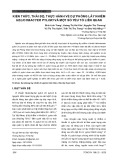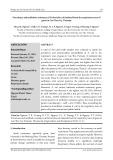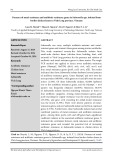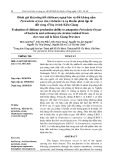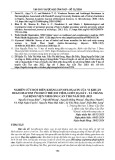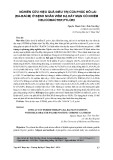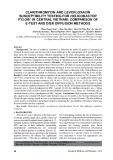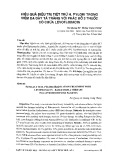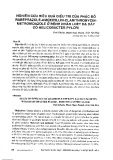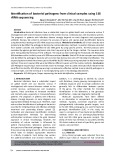
36
Journal of Medicine and Pharmacy, Volume 12, No.07/2022
Characterization of antibiotic resistance and genotyping of
Helicobacter pylori isolates in patients with gastroduodenal disease
Nguyen Thi Khanh Linh1, Tran Thi Nhu Hoa1, Phan Van Bao Thang1,
Phan Trung Nam2, Bianca Paglietti3, Le Van An1*
(1) Department of Medical Microbiology, Hue University of Medicine and Pharmacy, Vietnam
(2) Gastrointestinal Endoscopy Center, Hue University Hospital, Vietnam
(3) University of Sassari, Italy
Abstract
Background: In this study, we assessed the status of antibiotic resistance of H. pylori isolates to antimicrobial
agents at Hospital of Hue University of Medicine and Pharmacy in Central Vietnam and identified the
underlying molecular mechanisms related to tetracycline and amoxicillin resistance. In addition, the cagA,
cagE, cagT, vacA, iceA genotypes of H. pylori strains were investigated to predict clinical outcomes. Materials
and methods: H. pylori was successfully cultured in 52 patients with different gastrointestinal disorders
at the Hospital of Hue University of Medicine and Pharmacy in Central Vietnam. The minimum inhibitory
concentrations (MICs) of five antimicrobials; clarithromycin (CLR), metronidazole (MTZ), levofloxacin (LE),
amoxicillin (AMX) and tetracycline (TE) were determined by the E-test method. Genetic determinants of AMX
and TE resistance were identified with the polymerase chain reaction (PCR), followed by sequencing and gene
analysis. Allelic variants of cagA, cagE, cagT, vacA, iceA were identified by the PCR. Results: The resistance to
CLR, MTZ, LE, AMX, and TE were 90.4%, 86.5%, 65.4%, 40.4% and 0%, respectively. Multidrug resistance was
observed in 88.5% of the isolates investigated. Several known AMX resistance mutations were identified in
PBP1A (A369T, V374L, S543R, T556S, N562Y), whereas a known mutation in 16S rRNA (A926G) was detected
in strains with higher MIC level (TE MICs of 0.25 and 0.5 mg/L). The cagA, cagE and cagT genotypes were
found together in 46 isolates (88.5%), vacAs- region genotype in 51 (98.1%, predominantly vacAs1), vacAm-
region genotype in all strains studied (vacAm1 - 51.9%, vacAm2 - 40.4%, vacAm1 and vacAm2 - 7.7%), iceA1
in 22 (42.3%) and iceA2 in 20 (38.5%) of strains. The allelic variant vacAs1m1 was prominent (57.4%), and
vacAs1m2 (42.6%). Conclusion: Overall, resistance rates to CLR, MTZ, LE and AMX were high in H. pylori
from Central Vietnam, except for TE, which serves as a foundation for developing local guidelines for more
effective therapeutic strategies. Neither the single genes nor the combination of genes was significantly
helpful in predicting the clinical outcome of H. pylori infection in patients in our study.
Key words: H. pylori, antibiotic resistance, genotype.
Corresponding author: Le Van An. Email: lvanvs@huemed-univ-edu.vn
Recieved: 31/8/2022; Accepted: 15/11/2022; Published: 30/12/2022
DOI: 10.34071/jmp.2022.7.5
1. BACKGROUND
Helicobacter pylori (H. pylori) infection almost
always results in chronic gastritis, with only a small
but significant proportion of infected individuals
developing severe inflammation leading to peptic
ulcer disease (PUD), even gastric carcinoma and gastric
mucosa-associated lymphoid tissue lymphoma. The
successful eradication of H. pylori is important for
preventing and treating gastroduodenal disease. The
antimicrobials most widely used for H. pylori therapy
include clarithromycin (CLR), metronidazole (MTZ),
levofloxacin (LE), amoxicillin (AMX) and tetracycline
(TE). The resistance rate has continued to increase
worldwide and varies significantly according to the
geographic region [1]. Therefore, Maastricht V
Consensus Report recommends that local surveillance
of H. pylori antibiotic resistance is mandatory to
select appropriate eradication regimens according
to local resistance patterns [2]. Phan et al. conducted
an evaluation of antibiotic resistance to the four
commonly used antibiotics against H. pylori at a
tertiary care hospital in Central Vietnam from 2012
- 2014 and showed that resistance rates of H. pylori
to CLR, LE, MTZ and AMX were 34.1%, 27.9%, 72.0%
and 1.1%, respectively [3]. Previous studies have
shown that certain point mutations in 16S rRNA
confer resistance to TE; meanwhile, some amino
acid substitutions in penicillin-binding protein 1A
(PBP1A) confer AMX in H. pylori [4], [5]. Although
H. pylori infection is widespread worldwide, most
infected individuals remain asymptomatic. The
clinical outcome of H. pylori infection is most likely





